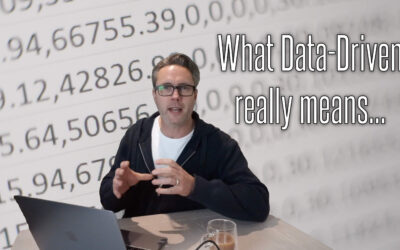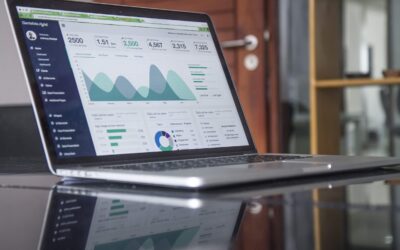This article is part of a series being developed jointly between Saltare and Bloor Research (a leading independent research and analysis house that helps companies to intelligently evolve) to promote the use of analytics and make enterprises ready to make better decisions, with more confidence, and not be daunted by perceived technical barriers.
BI Dashboards
BI dashboards have been a staple BI solution for many years. KPI dashboards are one of the first things people think of when they imagine their business’s activities being driven and supported by smart, actionable information. Yet BI dashboards can also be some of the least effective BI solutions. All too often, they are developed with a lot of focus on the latest and most impressive ways of visualising data, and the end result looks very impressive but, in reality, it does little to benefit the organisation that it was built for.
And it’s not just a matter of how BI dashboard content is presented; the content itself is also a crucial aspect. That may seem obvious, but it’s surprisingly often the case that the KPIs and metrics displayed on a dashboard are not very actionable, or have little relevance to what the business needs to do in order to achieve its goals.
The effective visual display of information has been the subject of much research, most notably by Stephen Few who has written some excellent books on this topic, and which I recommend to anyone who is designing or building dashboards. So rather than recycling that advice, I will instead focus on the other subject – BI dashboard content. Naturally, even when information is being very effectively displayed, if that information is not relevant or if people don’t know what to do with it, then it is of little value.
Understanding problems with BI dashboard content
When people look at the BI dashboards in your business right now, do they completely understand how the information they provide relates to their individual objectives or the goals of your business? Do they have a confident understanding of what to do in response to the story that your dashboards are telling them? These are important questions to ask, as they will reveal situations where your dashboard content is at best ineffective or is at worst creating business problems instead of business benefits. When BI dashboards display the wrong content, two sets of issues arise:
1) Unnecessary distractions and analysis challenges are created
The purpose of a BI dashboard is to deliver high-level information, often in the form of KPIs. Therefore when a business responds to dashboard content, that response will include using or creating some more detailed information, to reveal the story behind the high-level KPIs. If the KPIs aren’t entirely relevant to business objectives, or if people don’t accurately interpret them, then this more detailed analysis ends up sending people off in the wrong direction or down pointless rabbit-holes.
You can see this happening whenever people are asked to run queries or create spreadsheets in response to someone senior taking an interest in abstract metrics that few other people are familiar with. Time and effort is spent running analyses that might generate some meaningful insights, but are more likely to distract people away from higher-value activities which actually contribute to the achievement of business goals. This behaviour is like setting off on a long journey with only a vague understanding of your destination. You could get lucky and end up where you need to be, but the likelihood is that you’ll be a few degrees adrift at the start, and you’ll eventually end up in the middle of nowhere, either completely lost or facing a long hike to get back on track.
2) The broader value of BI is undermined
BI dashboards can be easily written-off as pointless tools which exist only to give people in senior roles something interesting to play with. The risk of this happening is increased by situations like the one described above. If people feel like they’re having to spend time and energy on analysing and addressing the root causes of KPIs that they don’t believe in, then a sense of rejection forms around all of the BI technology and processes responsible for delivering those KPIs.
It’s not the technology’s fault, of course. But in an effort to reject BI that’s seen as irrelevant and do things differently, people will seek to work with other data and BI tools. This is one reason why businesses that fail to control BI culture, end up struggling with a siloed BI infrastructure.
Dashboards exist at the top of a business’s BI solution hierarchy. So any shortcomings in the content that they deliver will inevitably cascade to all of the other BI solutions below, and this will, in turn, create challenges for the business processes that rely on those BI solutions.
The key to effective dashboard content
Most people reading this article will already know that BI dashboard content must be both relevant and actionable. But let’s dig deeper into what that actually means, to understand what you really need to do to create a relevant and actionable dashboard.
The key to getting dashboards right is to realise that effective BI dashboards don’t exist in isolation. They are just one part of a broader framework of BI solutions which work together as a system for delivering relevant and actionable insights. Crucially, your dashboard content must simultaneously do two things: It must relate directly to your business’s goals, and be easily translatable into processes that occur in response to KPIs. Information is only valuable if you know what it means, and you know what to do about it. In dashboards, and in BI generally, relevant and actionable are entwined.
Take another look at what’s in your business’s BI dashboards, and consider not only how relevant that content is, but also examine all of the ways that your business should or could respond to that dashboard content. What’s really happening when people use those dashboards? Does primed and efficient follow-up analysis swiftly drive effective actions? Or do pockets of chaos erupt as people scramble to understand what to do next?
It can be tempting for BI projects to start by delivering just some dashboards first, because they showcase the capabilities of BI technology and do a good job of pleasing senior stakeholders. The plan is often to start at the top with some dashboards and work down to more detailed reporting in later project phases. But this is a common mistake. Dashboards should never be delivered as standalone tools, they must always be accompanied by analysis solutions or capabilities that are designed and prepared to catch the high-level awareness that dashboards create, and rapidly develop it into deeper insights that drive accurate and valuable business activities.
On their own, BI dashboards have a hard time delivering real business value. Give your dashboards the best chance of success, and make sure your business has a fully prepared response to what your dashboards may be telling you.
For further insights check out our data solutions that deliver here!





0 Comments